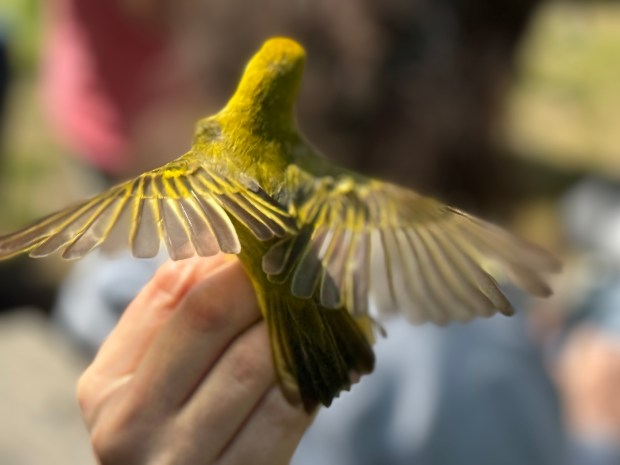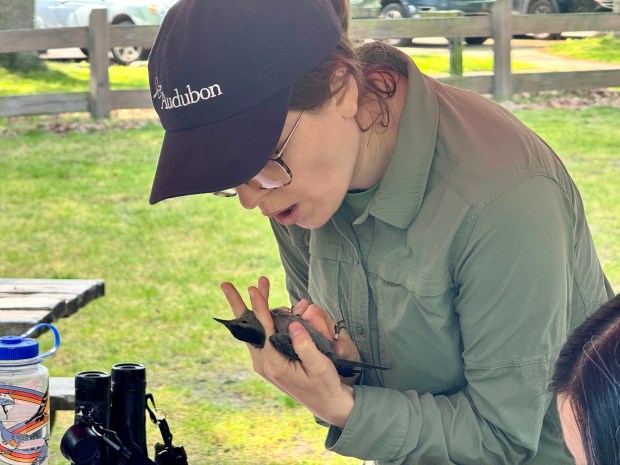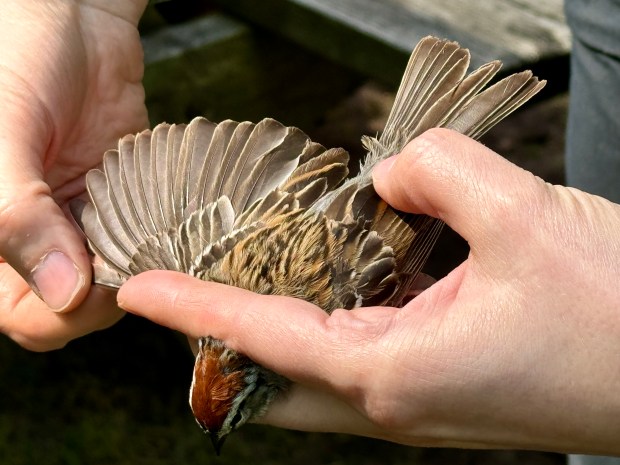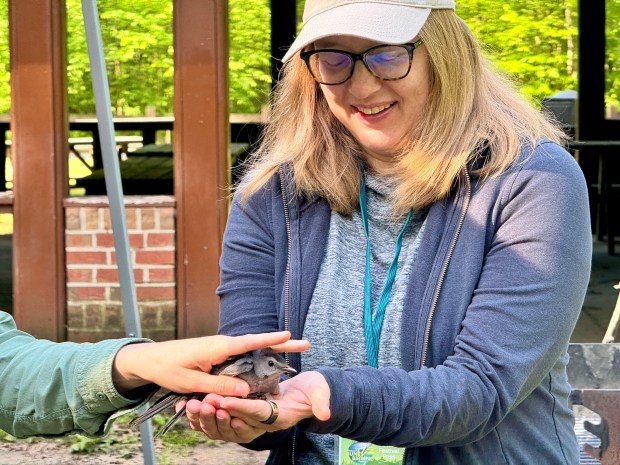It was a slow morning for catching birds at Indiana Dunes State Park on Thursday despite using four nets, but Indiana Dunes Birding Festival participants got to see a variety of birds being studied by researchers.
The nets are made with threads so fine that birds have a hard time seeing them, explained Jacob Drucker, a graduate student at the University of Chicago. The nets, 6 to 12 meters long, have small pockets to hold birds that fly into them. Drucker and his partner Iris Fried, a graduate student at Miami University in Ohio, checked the nets every half hour, bringing back captive birds to be examined.
Last year, around 26 species and 79 individual birds were caught and studied during the festival, said Stephanie Beilke, with Audubon Great Lakes.
“They’re safe and they’re comfortable” in the pockets, Drucker said. A captive cardinal was fussy, but others were more lackadaisical.
Birdwatchers at the festival, including Jennifer Jones, of Wichita, Kansas, watched the process of examining, measuring and weighing the birds. Jones, who briefly held a gray catbird before it was released, was glad for the opportunity. “It’s really special because we don’t normally get to see birds that close up,” she said.
Drucker and Fried have been interested in birds since they became birdwatchers in New York City.
Fried is heading to Kenya this summer to study birds there. Drucker, who is working on his doctorate, is studying migratory birds in South America.
“I’ve been banding birds on and off for about a decade,” Drucker said.

Scientists have been banding birds for several decades, building a database of information that researchers are using now to look at issues like climate change and how it affects bird migration. Future researchers will study many other issues, using data collected now by individuals banding birds, Drucker said.
In the last decade, scientists have begun analyzing the data in the most meaningful ways, he said. “We can do things we’ve never done before at relatively low cost,” he said.
Migration patterns have been known for years, but they’re shifting. “There’s definitely early migration,” Beilke said, with birds in the eastern United States migrating five days earlier, on average, than before.

The festival dates are set for a time when spring birdwatching is at its peak here.
“There’s always going to be individuals that are arriving way outside the average,” Beilke said.
“Sunday night and Monday night, I know we had a lot of movement,” she said. “They’ll keep coming through until the end of May.”
Within migration season, conditions for flying are best about 10% of nights, Drucker said. “Birds are more vulnerable on a couple of different days.”
On those nights, based on weather predictions, residents can help the birds by turning off lights.
“Temperature is the big predictor in the spring” of when it’s best for birds to travel, Drucker said.
Beilke showed one captured bird’s breast muscle, above the sternum, to eager birdwatchers. “Their breast muscles really power their flight,” she said.
Indiana Dunes State Park’s Wilson Shelter has proven to be a good venue for studying the birds, Beilke said. There’s a woodland right next to a wetland, offering a wider variety of birds.

“The conservation scene here is amazing,” Frier said. “I’ve got a lot of love for prairie and grass habitats.”
Among the birds caught and banded Thursday were a male chipping sparrow, 1 year old, and a female yellow warbler, 2 years old. “These yellow warblers, they’re moving through right now,” Beilke said. This area is a breeding ground for them.
Doug Ross is a freelance reporter for the Post-Tribune.




